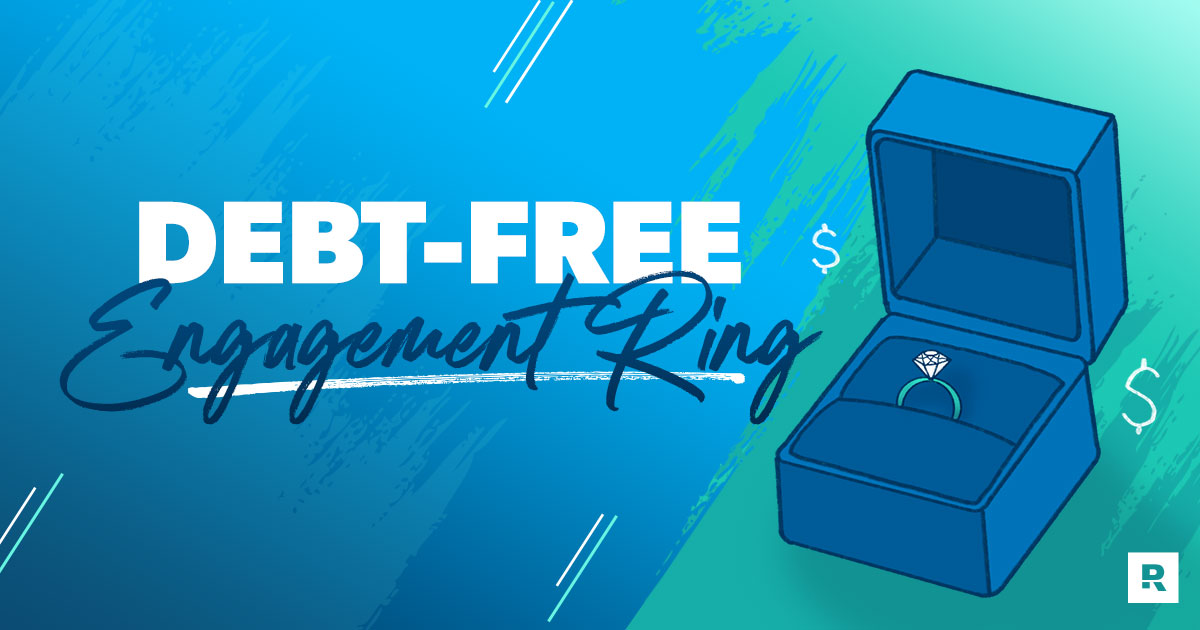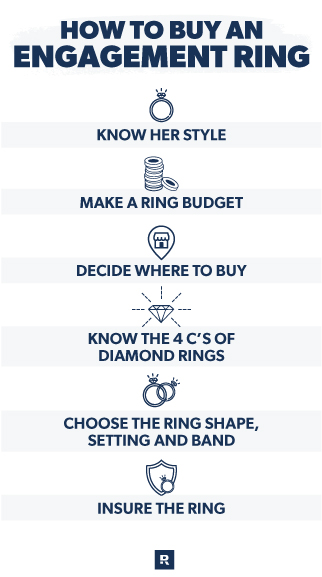So, you’re thinking about popping the question:
“Will you marry me?”
It’s one of the most important decisions of your life. And asking the love of your life to marry you means you’ll want to be prepared with a beautiful engagement ring. But how much should you spend on an engagement ring?
Believe it or not, an engagement ring can be one of the biggest purchases you’ll ever make, besides a house or a car. According to The Knot Jewelry and Engagement Study, the average cost of an engagement ring comes in at $5,500.1
If you’re feeling a little lost when it comes to learning about engagement rings, that’s okay. We’ll talk about how to pick an engagement ring that makes her eyes light up—without going into debt to do it.
1. Know Your Fiancée’s Style
If you two are planning on getting engaged, odds are you’ve talked about what your next steps are. Find out if your future fiancée wants the ring to be a surprise or if she wants to go ring shopping with you to drop some helpful hints. If that’s the case, more power to you. You can cross the ring off your list and put your efforts into planning that extra-special proposal. Just remember to set a budget, stick to it, and pay cash no matter what.
Get expert money advice to reach your money goals faster!
And if you’re planning a surprise proposal, there are a few ways to learn how to pick an engagement ring she’ll love. First things first: Get to know your lady’s style. Before you ask “How much should an engagement ring cost?”, you need to have an idea of the jewelry style she likes. Vintage? Minimal? Modern?
Then you can move on to other details: Would she like one stone or several? A bright shiny diamond or a deep blue sapphire? Here are some other ways to get a feel for the perfect engagement ring style:
- Use Pinterest. Your honey might have a Pinterest wedding board where she’s saved pictures of engagement rings she likes.
- Ask her best friend or family. If her mom or sister know her better than anyone, you can get their input about which engagement ring style she’ll love.
- Look at her jewelry collection. If she wears rings already, peek at her collection to see if there are any styles that she prefers or wears more than others.
2. How Much Should You Spend on an Engagement Ring?
All right, time for the question I’m sure you’re all wondering: How much should a man spend on an engagement ring? There’s no right number because it depends on your money situation—but you’ll still need to be intentional and make a budget.
One month of your annual income is usually plenty to get a great ring, but don’t spend more than two to three months of your income.
And when you’re figuring out how much to spend on an engagement ring, never go into debt to buy your girl the perfect ring. That means you should never buy a ring with a credit card, a bank loan or financing. (Besides, the size of the ring has nothing to do with the success of your marriage.)
Pay as much as you’ve budgeted for in cash. Paying with cash can even get you a better deal. Jewelry has a super high markup, and paying with cash opens the door to negotiation.
3. How to Save Money on an Engagement Ring
Many chain or big-box jewelry stores aren’t known for handing out discounts, but it never hurts to ask for a percentage off your purchase. They’ll either say no, or they’ll surprise you with a yes. (Even jewelry salespeople know cash means money in their hands right now rather than payments in the future.)
Payment options like layaway, financing or jewelry store credit cards are rip-offs because of their ridiculous interest rates. Saving up and paying cash will save you a ton of money in the long run. And here’s the thing: That ring will look a lot less sparkly if it comes with years and years of payments.
And when you’re figuring out how much to spend on an engagement ring, remember this: Small compromises on the quality of the diamond can save you money without diminishing the beauty of the engagement ring itself. That’s all part of the four C’s of choosing a diamond, which we’ll look at in just a minute. Just keep in mind, a trusted jeweler can help you find a beautiful stone (that’s not perfect, but not bad either—right in the middle) within your wedding budget.
4. Decide Where to Buy the Ring
Once you’ve decided your ring budget, you can choose where to buy an engagement ring. No matter where you shop, it’s helpful to look at rings with someone who knows a bit about diamonds and jewelry so you don’t get ripped off. But if you don’t have someone to shop with, just make sure you’re shopping somewhere that you feel comfortable and that will allow you to stick to your budget.
- Online jeweler: There are plenty of jewelry stores online, like Brilliant Earth or Blue Nile. You can design your own ring or choose from their predesigned inventory.
- Traditional jewelry store: You can visit a brick-and-mortar jewelry chain (like Jared’s) or a mom-and-pop jewelry store. Just beware of the retail markup here.
- Pawn shop: Believe it or not, you can get beautiful engagement rings at pawn shops for a fraction of the cost.
- Family heirloom: Hey, no one says you have to go out and purchase a brand-new ring. Using a family heirloom can have tons of special meaning (and save money).
- Trunk show or gem show: If you’re looking for a unique stone, try a trunk show or gem show for wholesale prices and unique selections.
- Big box stores: Don’t knock Costco or Sam’s Club when you’re looking for jewelry—including engagement rings.
The Four C’s of Diamond Rings
Now that you’ve narrowed down the style of ring you’re looking for, you can learn about the quality of jewels. You don’t have to be a gemologist to pick out a stunning diamond, but you will get a better deal if you know the four C’s. Those C’s stand for cut, color, clarity and carat weight.2 And if you can figure out which of the four C’s is most important to your fiancée, you can save money on the engagement ring
Cut
A diamond’s cut has the most impact on its overall look. It refers to the angles of the diamond, not the shape. Cut impacts how well the stone interacts with light, which is what gives diamonds that beautiful sparkle we all love. Who doesn’t love a good sparkle? A diamond can have great color, clarity and carat, but if the cut isn’t right, it won’t have that signature sparkle it’s known for.
Color
Diamond color is graded on a scale from D (colorless) to Z (light yellow). Although the variations in color are so subtle they’re pretty much invisible, they can make a huge difference in the price. Colorless diamonds (D) are going to be the most expensive. If you want the best value, check out near colorless diamonds (G–J).
Clarity
A diamond’s clarity is graded on a scale from flawless to included. Those imperfections can be internal (inclusions) or external (blemishes). No diamond is perfect, but the fewer imperfections a diamond has, the more expensive it will be. Keep that in mind when you’re planning your budget.
Carat Weight
A heavy stone equals a hefty price tag. And here’s a fun fact: People like round numbers, so you’ll pay a premium price for a 1.00 carat. Save money by going slightly lower, say 0.85–0.95 or 0.65–0.73. The untrained eye can’t even tell the difference. And if you’re really concerned about the size, a quality jeweler can always make a diamond look a little larger through setting and shaping. (Halo ring for the win!)
Choosing the Ring Shape, Setting and Band
This is the fun part of learning how to pick an engagement ring—choosing the frame and metal to hold the jewel in place. (I’d recommend you decide where to buy an engagement ring first, because that can affect the options available.)
Shape
Diamonds can be cut into several different shapes: round, cushion, princess, pear, marquise, oval, emerald . . . the list goes on and on. It’s really up to your future fiancée’s taste and your personal budget. Here’s a tip: Round diamonds are pretty popular and tend to be pricier, so going for a unique shape could help you save money.
Setting
The setting is how the diamond is placed on the ring: solitaire, pavé, halo, channel and tension are all options. Make sure you know what your future fiancée likes—or more importantly, what she doesn’t like. When in doubt, ask her what she likes, or consult one of her trusted friends if you’re trying to keep things hush-hush.
Band
Then there’s the ring band, which can be yellow, rose or white gold, platinum, silver or palladium. Each metal has pros and cons. For instance, platinum is a little more expensive than gold, but it’s also more durable. Gold is classic, timeless and easy to polish, but it wears down faster and could require more maintenance (aka more money) over the lifetime of the ring.
5. How to Insure an Engagement Ring
When you make a big purchase like an engagement ring, don’t skip the insurance. Sure, it may add some money to the total cost of the ring, but it’s worth protecting. Plus, you worked really hard to save up for that beautiful engagement ring. You don’t want anything to happen to it. So, here are some coverage options:
Homeowners or Renters Insurance
Usually, your policy will let you add the value of a pricey item like an engagement ring to your coverage. Just make sure you know exactly how you’re covered. (Some policies only cover the ring if it’s stolen or damaged in a fire.) Make sure your policy amount is large enough to cover the replacement cost of the ring.
Actual Value Policies
This will cover the value of the ring minus its depreciation over time. If you buy the ring for $5,000 then lose it six years later, the insurance policy will only cover a portion of that. Womp, womp. (That’s why this insurance option is the cheapest to purchase.)
Replacement Insurance Policies
This type of policy will refund the market value of the engagement ring. If you bought a ring with a solitaire setting and a diamond with beautiful cut and clarity, you’ll be refunded for the current market price of that ring. You could end up getting more money than you initially paid (based on appreciation).
It’s About the Marriage, Not the Ring
I’ll never forget the day my husband, Winston, proposed. It was one of the best moments of my life—and I want you to have that same great start as you go into your marriage.
Remember: If you’re intentional with your budget and know how much to spend on an engagement ring, you’ll be off to a great start. But at the end of the day, a ring is just a symbol of the love you two share. The size, cut or setting of the engagement ring has absolutely nothing to do with having a long and happy marriage.
Ready to get started on a wedding and honeymoon budget? Download the EveryDollar app! It will help you save for big-ticket items, like a wedding venue and catering company, and it will help you and your spouse handle your money together as a married couple. Try EveryDollar for free today.




